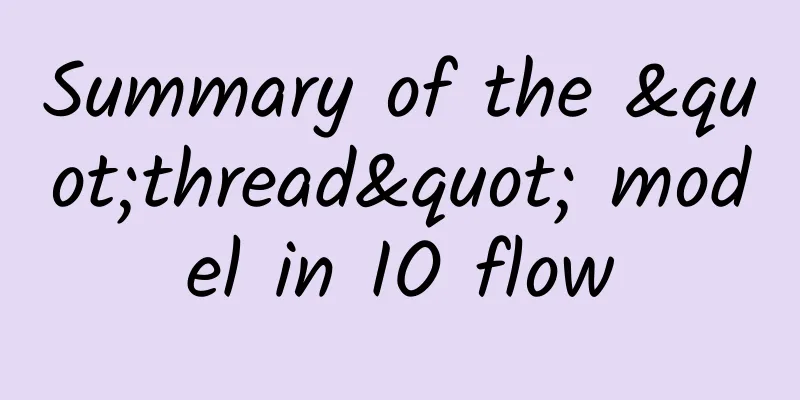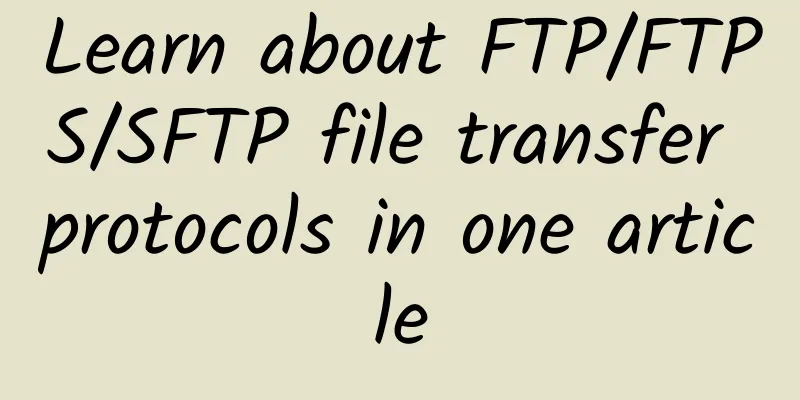Summary of the "thread" model in IO flow

1. Basic IntroductionIn the IO flow network model, take the common "client-server" interaction scenario as an example; The client and the server communicate "interact" synchronously or asynchronously. When the server performs "stream" processing, it may be in blocking or non-blocking mode. Of course, there are also custom business processes that need to be executed. From the processing logic, it is in the form of "reading data-business execution-response writing data"; Java provides "three" IO network programming models, namely: "BIO synchronous blocking", "NIO synchronous non-blocking", and "AIO asynchronous non-blocking"; 2. Synchronous blocking1. Model diagramBIO stands for synchronous blocking. When the server receives a request from the client, it starts a thread to process it. The "interaction" will be blocked until the entire process is completed. In this mode, if the client request response is in a high-concurrency scenario with complex and time-consuming processes, there will be serious performance issues and too many resources will be occupied; 2. Reference Cases[Server] Start ServerSocket to receive client requests. After a series of logic, send messages to the client. Note that the thread sleeps for 10 seconds here. public class SocketServer01 { [Client] Socket connection, first send a request to ServerSocket, then receive its response. Since the simulation on the Server side is time-consuming, the Client is in a long-term blocking state; public class SocketClient01 { 3. Synchronous non-blocking1. Model diagramNIO is synchronous non-blocking. The server can implement one thread to handle multiple client request connections, which greatly improves the concurrent capability of the server. In this mode, the client's request connection will be registered with the Selector multiplexer, and the multiplexer will poll and process the IO stream of the request connection; 2. Reference Cases[Server] A single thread can handle multiple client requests and poll the multiplexer to see if there are any IO requests; public class SocketServer01 { [Client] continuously writes data to the channel every 3 seconds, and the server continuously reads data by polling the multiplexer; public class SocketClient01 { 4. Asynchronous non-blocking1. Model diagramAIO stands for asynchronous non-blocking. It uses asynchronous mode for both "reading" and "writing" of data in the channel, which greatly improves performance. This is very similar to the conventional third-party docking mode. When a local service requests a third-party service, the request process takes a long time and is executed asynchronously. The third party makes the first callback to confirm that the request can be executed; the second callback is to push the processing result. This idea can greatly improve performance and save resources when dealing with complex problems: 2. Reference Cases[Server] Various "accept", "read", and "write" actions are asynchronous, and the calculation results are obtained through Future; public class SocketServer01 { [Client] The related "connect", "read", and "write" method calls are asynchronous, and the calculation results are obtained through Future; public class SocketClient01 { 5. Reactor Model1. Model diagramFor more details, please refer to Doug Lea's IO document. 1.1 Reactor Design PrinciplesThe Reactor mode is based on event-driven design, also known as the "reactor" mode or the "distributor" mode. After the server receives multiple client requests, it dispatches the requests to the corresponding threads for processing. Reactor: responsible for monitoring and distributing events; Handler: responsible for processing events, core logic "read", "decode", "compute", "encode", "send response data"; 1.2 Single Reactor Single Thread[1] The Reactor thread listens to the client's request events through select, and distributes them through Dispatch after receiving the events; [2] If it is a connection request event, Acceptor obtains the connection through the "accept" method and creates a Handler object to handle subsequent business; 【3】If it is not a connection request event, Reactor will hand the event over to the currently connected Handler for processing; 【4】In the Handler, the corresponding business process will be completed; This mode processes all logic (connection, reading, writing, and business) in one thread to avoid multi-threaded communication, resource competition, and other issues, but there are obvious concurrency and performance issues; 1.3 Single Reactor Multithreading[1] The Reactor thread listens to the client's request events through select, and distributes them through Dispatch after receiving the events; [2] If it is a connection request event, Acceptor obtains the connection through the "accept" method and creates a Handler object to handle subsequent business; 【3】If it is not a connection request event, Reactor will hand the event over to the currently connected Handler for processing; [4] In the Handler, it is only responsible for event response and does not handle specific business. It sends data to the Worker thread pool for processing; 【5】The Worker thread pool will allocate specific threads to process the business, and finally return the results to the Handler as a response; This mode separates the business from the Reactor single thread, allowing it to focus more on event distribution and scheduling. The Handler uses multiple threads to fully utilize the CPU's processing power, making the logic more complex. The Reactor single thread still has high concurrency performance issues. 1.4 Master-Slave Reactor Multithreading【1】 The MainReactor main thread listens to the client's request events through select, and distributes them through Dispatch after receiving the events; [2] If it is a connection request event, Acceptor obtains the connection through the "accept" method, and then MainReactor assigns the connection to SubReactor; 【3】If it is not a connection request event, MainReactor assigns the connection to SubReactor, and SubReactor calls the Handler of the current connection to handle it; [4] In the Handler, it is only responsible for event response and does not handle specific business. It sends data to the Worker thread pool for processing; 【5】The Worker thread pool will allocate specific threads to process the business, and finally return the results to the Handler as a response; In this mode, the Reactor threads have clear division of labor. The MainReactor is responsible for receiving new request connections, and the SubReactor is responsible for subsequent interactive services. This mode is suitable for high-concurrency processing scenarios and is the mode adopted by the Netty component communication framework. 2. Reference Cases[Server] provides two EventLoopGroups. The "ParentGroup" is mainly used to receive client request connections, and the actual processing is transferred to the "ChildGroup" for execution, that is, the Reactor multi-threaded model; @Slf4j [Client] Establish a connection with the server through the Bootstrap class. The server starts the service through ServerBootstrap and binds to port 8989. Then the server and client communicate. public class NettyClient { 6. Reference source codeProgramming Documentation: |
<<: 20,000 words of detailed explanation! 32 classic questions about Netty!
>>: How does 5G promote innovation in manufacturing?
Recommend
What’s next after the first 5G standard is released?
On June 14, Beijing time, the International Mobil...
How difficult is it for a woman to work in communications?
It is well known that the number of women working...
Donghua's anti-unified prescription system helps hospitals develop an "indestructible body"
Recently, a piece of news that "Apple China ...
Stay true to our original aspiration and keep moving forward | What did they gain from their journey to Huawei's ICT ecosystem?
[51CTO.com original article] Summer is coming to ...
Key Roles of Artificial Intelligence in Mobile App Development
[[431728]] 【51CTO.com Quick Translation】 Today, t...
Edge computing and fog computing explained
By processing data at or near the source of the d...
What is blockchain fork? I finally understand
I have previously written about how Bitcoin minin...
What do you think of the "5G is useless theory"? Communications industry netizens have something to say
Since the beginning of this year, 5G has become t...
Breakthrough in electricity usage could lead to big savings for data centers
Serial links are responsible for transferring dat...
[Black Friday] RAKsmart cloud servers are 30% off, cluster servers are half price for the first month, flash sales servers start at $30/month
Domestic and foreign merchants have successively ...
One router makes all the appliances in the house smart. Huawei's ecosystem is taking over Xiaomi
At present, among China's smart home brands, ...
The operating data of the three major operators in January was released: China Telecom’s 5G users are about to exceed 100 million
[[383106]] In a blink of an eye, the Spring Festi...
Senhua Yiteng launches CDN intelligent service management platform
Adhering to the service-first concept, Senhua Yit...
Don't forget to bury the network cable when renovating. There are also ways to bury the network cable.
Every year in the "golden March and silver A...
WOT Li Jian: The evolution of the eleme container platform
[51CTO.com original article] The Global Software ...









